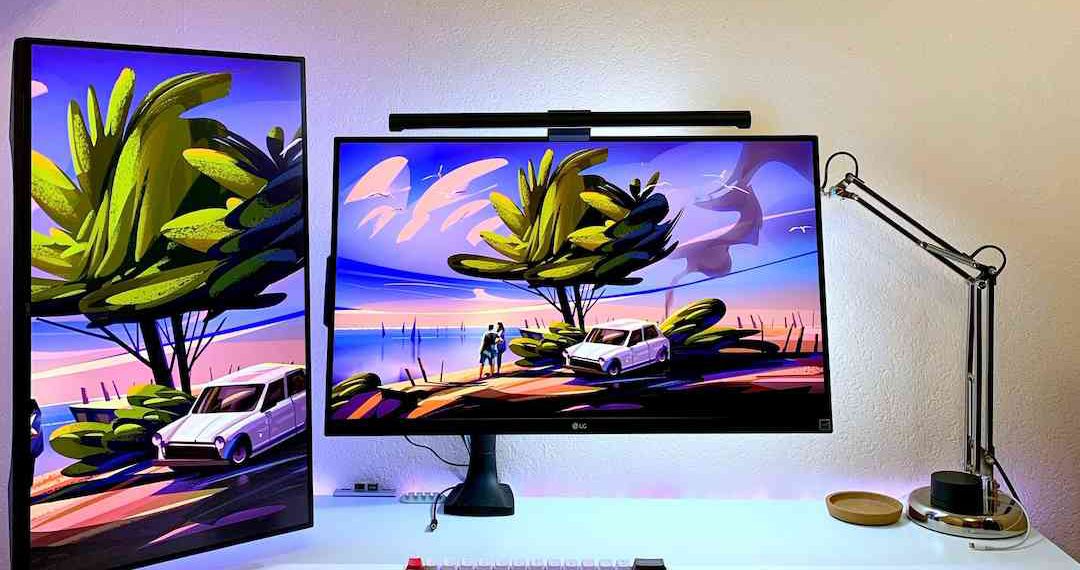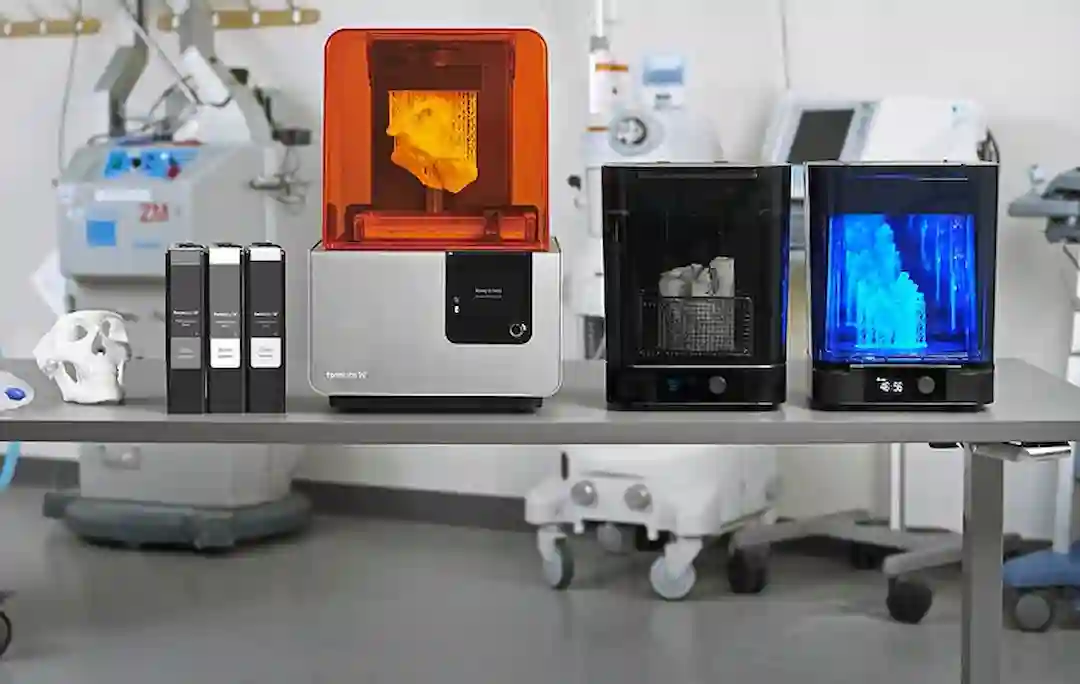- This is complete guide where we will be taking a deep look at the best multi-monitor set-ups possible on modern laptop and desktop computers. We’ll cover duel, triple, quad, all the way up to 6 monitor setups or more.
- We’ll look at the required adapters and accessories, links included (we may earn advertising commission if items purchased through link)
- How to complete the installation process for different ports
- And major pitfalls to avoid
Disclosure: This post contain affiliate links, we may earn advertising commissions for sharing products we know and love.
The first step in setting up our new multi-display setup is to take a careful look at our computer to determine the available ports. Modern laptops these days come in various port configurations from the ultra-portables with just one or two USB type C thunderbolt 3, USB 3.2 ports, to fully featured heavy hitters that still feature full-sized display ports and HDMI along with Superspeed (SS) USB 3 ports.
Having multiple display-out options would certainly assist in setting up multiple monitors with your laptop. But that’s not always the case. So in the interest of covering as many use-cases as possible we are going to cover multi-monitor set-ups with all the most common ports. Feel free to jump to the setup with the port that is available on your machine. Let’s begin!
Multi monitor setup for laptop with USB 3.x
If your available port options on the laptop are limited to just one or two Superspeed USB ports (marked with either the SS logo or blue color), you will still be able to set-up a multi-monitor arrangement with between 2 to 7 (two to six additional monitors plus the laptop display) displays at your disposal.
You will need two types of additional accessories:
- a powered USB hub; and
- USB video adapters (as many as needed for the additional monitors)
The powered USB hub will allow you to connect as many video adapters for the multiple displays as you’d like through a single USB 3 full-size port, so it is best to get a well-reputed model.
As for the USB video adapters, just make sure to get a DisplayLink certified accessory.
Choosing the right accessories
There a few good options to choose from when selecting the adapters and hubs to expand your computer’s connectivity to support multiple displays. Below are the two best available choices, designated as setup 1 and setup 2.
Setup 1
The best-suited USB hub we could find is the Rosonway RSW-A10 10-port USB 3 externally powered USB hub. While you will only need 6 active ports at most for the video adapters, the Rosonway RSW-A10 crucially comes with a 36 Watt AC Adapter that would be more than adequate for six video adapters as well as any other accessory you might need or want; a solid aluminum and ABS build for sturdiness, and individual on/off switches for all 10 of the USB ports.
As for the best USB Video adapter; the DisplayLink certified Diamond BVU-5500H (comes in both HDMI and DisplayPort models) is, in our opinion, by far the best value gadget that supports up to 4k 60 Hertz output. It supports up to six monitors via a powered USB hub; and also, proudly boasts lifetime US-based customer support to guide you through the entire process if needed.
Setup 2
The other alternative USB hub, the one we went with and thus recommend is the Pluggable USB 3.0 7 port hub. Pluggable is a reputable name when it comes to multi-display adapters and accessories. The power rating is the same as the RSW, the only difference is the number of ports and the Pluggable does have individual on and off switch, which is either a plus or a minus depending on how you look at it.
For the USB video adapter, we used multiple “Pluggable USB 3.0 video adapters”. Those adapters can adapt USB 3 or 2 either to HDM. There is also a model for VGA, DVI adaptations.
We recommend using any cheapo connector to connect to DVI or VGA monitors with either the DisplayPort or the HDMI models. Still, it is recommended to use the same brand or at the very least the same DisplayLink version devices to ensure inter-operability for all the monitors.
Caveat: It needs to be noted here that both DisplayLink and non-certified USB video adapters rely on custom compression codecs. So, the performance of the multiple displays would be somewhat dependent on the overall capability of the CPU and GPU of the laptop. Also, keep in mind that running multiple programs simultaneously may be memory intensive in terms of RAM.
How to set it all up
Whether you use the above set-up or choose to go with a different powered USB hub and/or USB Video adapter, the “how” part of it remains the same:
- First of all, install the latest drivers on your laptop for the USB video adapter. A lot of times the drivers are automatically available through your operating system. You will also need the DisplayLink software if it’s not already installed.
- Next, plug your powered USB hub into the available USB 3/Superspeed port and also connect the power adapter to the USB hub itself. It will also work with USB 2, however there may be noticeable latency and performance problems.
- Now, connect the USB Video adapter to a free port on the USB hub, and connect your monitor to the Video adapter.
- If all is well, then the monitor should be detected and installed automatically by the laptop.
- Repeat the third and fourth steps for the remaining monitors for up to 6 additional screens plus the laptop.
- Finally, open the display management utility in the OS of your choice (Display settings in Windows 10) and arrange and configure the displays as per your requirement. We recommend using the Extended mode as that offers the maximum pixels for you to work with.
- If you’re using a wireless mouse or keyboard, it may be best to plug the dongle into the new USB hub rather the computer itself to prevent conflicting signals. This happened during our initial setup.
Multi-monitor setup for laptop with DisplayPort 1.2 and above
If your laptop features a DisplayPort (spec. 1.2 or above) either full-size or a mini variant, then setting up your multi-monitor arrangement will be a breeze.
DisplayPort 1.2 and above use a feature called Multi-Stream Transport or MST that allow compatible monitors to be daisy-chained for a native multi-display setup (unlike the USB 3 method which only supports multiple displays via special drivers).
DP 1.2 supports four 1080p (Full HD) displays or up to two 1600p (QHD) screens natively. Newer versions support more displays with version 1.4 allowing up to six 1080p displays or two 4K displays at 60 Hertz.
The only caveat here is the number of displays daisy-chained cannot exceed neither the maximum Video RAM nor the maximum number of displays supported by the GPU of the laptop.
Most integrated graphics on Intel laptops would support 3 displays. So, you could add only 2 more monitors. Intel Tigerlake, Ryzen Mobile, and discrete laptop GPUs from both nVidia and AMD usually allow up to 4 total displays. You could hook up 3 external monitors in addition to the laptop display. If you are unsure then check with the manufacturer before buying any relevant accessory or compatible DisplayPort Monitors that support Daisy chaining via MST.
Choosing the right accessories
Usually using an MST Hub with normal monitors (either DisplayPort or any other plug such as HDMI or DVI) will be the most cost-effective method since daisy chain-able monitors still command a premium over other similar models without this feature.
One of the best MST hub available is the Triple 4K DisplayPort Splitter by Cable Matters. This MST hub covers the full spectrum of DisplayPort versions up to version 1.4 with support for three simultaneous 4K @ 60 Hertz monitors. It even supports 8K, but all these resolutions are only available where the laptop GPU permits it. This goes ditto for the number of monitors as discussed earlier.
Another point to note is to buy a VESA certified cable. A good budget friendly cable that still holds up to pass VESA certification is the Club 3D CAC 2068. The 2-meter cable is 8K-ready and completely backwards compatible with all lower resolutions as well as DisplayPort versions.
Apart from the above two, just buy the appropriate conversion adapters for HDMI or DVI compatibility if needed.
How to set it all up
- First of all, MST in Extended or “Wall” mode is only officially supported on Windows, so if you are a Mac user then you would have to rely on a different port and method like the USB 3 method.
- With that out of the way, simply connect the MST Splitter hub to the available DP or mini DP port.
- Connect the additional power connector to the Splitter hub if needed or for safe measure.
- Connect your monitors to the Splitter hub either directly via DisplayPort or via appropriate adapters.
- That’s it! Since this is a native connection, you don’t need to fiddle around with anything else. At most you would need to set-up the correct order of your monitors via Display Settings.
Multi-monitor setup for laptop with USB Type C
If your laptop maker does not advertise display output from the type C port but states it as USB 3 or SuperSpeed, chances are that it will not support it. If that is your case, then either use a spare full-size USB 3 port or the type C port with an adapter to set-up the multiple monitors. There are many good adapters to use in this setup. A good adapter for that is the J5 create 4 HDMI port USBC C to HDMI adapter since most monitors support HDMI.
But if the Type C port on your laptop either has a DP logo (for DisplayPort) or a Thunderbolt symbol next to it, then the Type C port at the very least supports DP 1.2 native video output either by itself or inherently through Thunderbolt 3.
Also note that, USB type C is not backwards compatible or adaptable to USB 3.x with video transfer support. If your computer only support USB 3, refer to the USB 3.x section above.
Choosing the right accessories
We dived deep into the available accessories, but at last we came to the conclusion that using a simple type C to DP adapter would yield the highest value as well as quality.
The simple but effective Tomtoc type C to DisplayPort dongle adapter is the perfect companion if you want to set-up an MST hub with up to 3 external displays as we discussed in the DisplayPort section.
The Tomtoc is one of the few dongles that supports DP version 1.4 on type C Alt. Mode as well. More than that though, Tomtoc’s 24-month customer support and replacement policy for duds decided it for us.
For those who would like a more dock-style solution, the Mokin Docking Station provides 2 HDMI out ports as well as DisplayPort in addition to various card reader, and USB ports. Note that this dock can only power 3 simultaneous displays that too at 1080p each only. It can however, run a single external monitor at up to 4K.
Both of the above set-ups, owing to the native DisplayPort support, remains the same Plug and Play affair as before.
Multi-monitor setup for laptop with Thunderbolt
Thunderbolt integrates a native DisplayPort connection within its specification by use of an automatic alternative mode for DisplayPort support. Thunderbolt 2 integrates DP version 1.2, whereas the newer thunderbolt 3 integrates DP versions 1.2 and 1.4 on newer devices, whereas thunderbolt 4 integrates DP version 1.4 only.
For Thunderbolt 2, even the above-mentioned Triple 4K DisplayPort Splitter could be used since it offers a mini DP connector out of the box. You could save some money by buying a DP 1.2 model but honestly the price difference for triple-port splitters is quite insignificant.
As for thunderbolt 3 and 4, both these specifications use the USB Type C connector and superpose higher data transfer speeds and bandwidth and DisplayPort functionality via the Type C connector’s Alt. Mode.
Multi-monitor setup for desktop computers
While one could use any or a combination of the above methods for laptops on their Desktop systems. For a proper multi-monitor set-up on the desktop, it would be ideal to invest in a specialized GPU or graphics card.
Best graphics cards/GPU for multiple monitors
The best value GPU for multiple monitors has to be the Visiontek Radeon HD7750 Eyefinity with 2 GB GDDR5 VRAM. This GPU has six discrete mini-DP 1.2 ports all of which are capable of driving 4K monitors.
This GPU is not meant to do heavy gaming, video editing or heavy Compute. It is meant for people who need multiple monitors for more general tasks. The HD7750 also supports AMD’s Eyefinity software that assists in properly setting up multiple monitors for simultaneous use. It is a single-slot low power GPU that can practically fit inside any modern desktop PC.
The set-up is simple plug and play for this card. An important point to note though is that it is always best to use an “Active” adapter when connecting these AMD GPU DisplayPorts to DVI, HDMI or VGA ports.
The best gaming GPU(s) for multiple monitors
Very few gaming GPUs support 6 or more discrete display-out connections, however all modern gaming GPUs provide at least 4 discrete display-out connections in a mix of DisplayPorts, HDMI, DVI and/or USB-C. They also, generally, support additional monitors via daisy-chaining or via MST hub.
That being said, however, no modern gaming GPU can be had for even close to its recommended retail price right now, with the aforementioned cards retailing for many thousand dollars in some cases. So, the only practical options are the older value models like the 7750 above.
Getting the right monitors, mounts and desks
Now that we have covered how you could set-up multiple monitors, we must also discuss how to shop for the right monitors and the associated mounts for your set-up.
A general rule to follow here is to only consider the features you know are important for you, and compare the value any other feature may provide you:
- Think about the factors discussed above and how big you want the multi-monitor set-up to be in terms of physical space.
- Consider whether you need a continuous extended display for things like video-editing or immersive multimedia, or would discrete monitors suffice and figure out your desk-space needs accordingly.
- Gaming Desks tend to provide better value in terms of ergonomics, size and strength of the desk. The 63” desk from Vitesse is about half the cost of a similar office desk for example.
- It is always wise to buy VESA compatible monitors so that you could use standard VESA mounts or stands like the Vivo triple monitor stand up to 30-inch. Or else you may find yourself with monitors with no way to mount them then the stand they come with or having to spend extra on especial VESA adapters.
- Higher resolution monitors are sharper and provide more virtual workspace, but also cost more and need a better CPU, GPU and more memory to provide effective performance.
- High refresh rate monitors are only suited in such a set-up with a powerful desktop GPU; and lastly
- Buy the same model with the same resolution for your entire set-up. While different models with matching resolution can work, you save yourself a world of pain by making the right call now.







